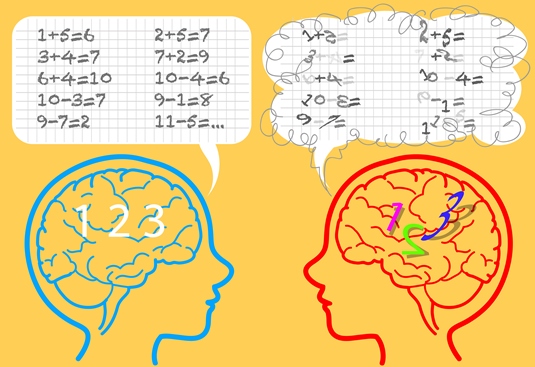
Dyscalculia primarily affects the learning process in relation to Mathematics. Two of the types of dyscalculia that have been identified are:
- Type 1: developmental dyscalculia where students exhibit a marked discrepancy between their developmental level and general cognitive ability as it pertains to Mathematics. As a basic indicator of developmental dyscalculia students will perform below expectations with no obvious explanation (e.g. general ability, emotional state or illness) available.
- Type 2: dyscalculia where students exhibit a complete inability to manage mathematical concepts and numbers. It presents as an enduring condition that affects the ability to acquire mathematical skills despite appropriate teaching.
Dyslexia and dyscalculia may co-exist, but not all students with dyslexia will have difficulties in Mathematics. However, dyslexia will affect all kinds of learning that depend on reading including Mathematics.
Dyscalculia may manifest itself through the student’s inability to conceptualise number, number relationships and outcomes of numerical operations (estimating). Students variously exhibit difficulties in the following areas: computation, direction, laterality, mathematical concepts, mental Mathematics, money, omissions, reading and writing numbers, reversals, rote counting, rules and formulae, sequencing, and time and time management. Students may be unable to comprehend or ‘picture’ mechanical processes as they often lack ‘big picture’ thinking.
Other symptoms of dyscalculia may be noted in poor athletic co-ordination, difficulty keeping scores during Physical Education and problems keeping track of whose turn it is during games. Transitioning between lessons, particularly at post-primary level may also be difficult. Students may also have a poor sense of direction, display a tendency to lose things and may seem absent minded. Additional problems may be seen in difficulties that arise in grasping concepts of formal music education such as reading music, and in students sometimes having poor name/face retrieval when recollecting individual’s names.
Strategies for Learning and Teaching
- Use concrete materials and start from practical activities.
- Avoid creating anxiety for the student.
- Establish the student’s preferred learning style.
- Teach more than one way to solve mathematical operations.
- Build on student’s existing knowledge.
- Try to understand the student’s errors, do not just settle for wrong.
- Concentrate on one concept at a time.
- Language should be kept to a minimum and specific cues given for various mathematical operations in word problems.
- Encourage students to visualise mathematical problems. Allow students to draw a picture to help them understand the problem and ensure they take time to look at any visual information such as charts and graphs.
- If the student does not have co-existing reading difficulties, encourage him/her to read problems aloud.
- In the early stages of teaching new mathematical skills ensure that the mathematical problems are free of large numbers and unnecessary calculations.
- Provide examples and try to relate problems to real-life situations.
- Provide students with graph paper/squared paper and encourage them to use this to keep the numbers in line.
- Ask to explain verbally how he/she arrived at particular solutions.
- Explain new concepts in a logical manner.
- Encourage students to teach a concept back in order to check understanding.
- Ensure worksheets are uncluttered and clearly laid out and provide ample room for uncluttered computation. Ensure that the page does not look intimidating.
- Limit copying from the board.
- Allow students to use computers and calculators, especially to self-correct.
- Provide students with extra time to complete tasks and encourage the use of rough work for calculations.
- Directly teach the language of Mathematics.
- Always bear in mind the language of Mathematics differs significantly from spoken English.
- Use consistent mathematical language both in your classroom and throughout the school.
- Make use of mnemonics and visual prompting cards to assist students in memorising rules, formulae and tables. Repetition is also very important.
- Always match the strategy to the student’s identified needs and abilities.


